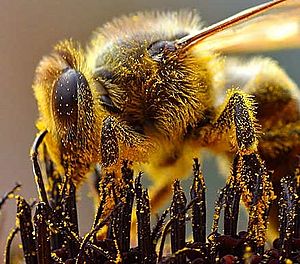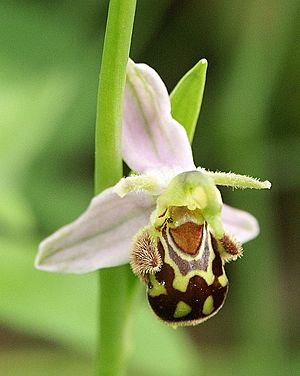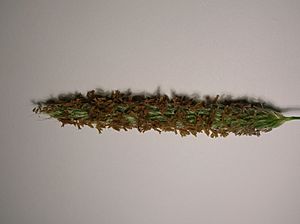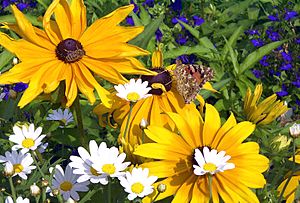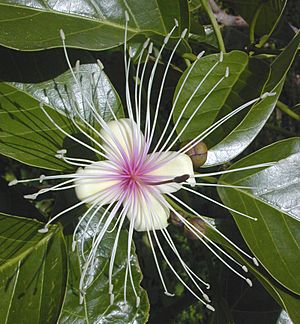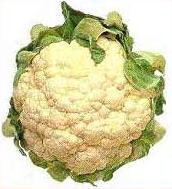Flower facts for kids
A flower is a special part of a plant. You might also hear flowers called a bloom or blossom. They grow on a thin stem or stalk that holds them up. Flowers have colorful petals. Inside the petals are the parts that make pollen and seeds.
Flowers are how flowering plants, also known as Angiosperms, reproduce.
Many plants have very colourful flowers. When a plant 'flowers' or 'is flowering', it means this colorful part is growing and opening up. There are many different kinds of flowers all over the world. Even in very cold places like the Arctic, flowers can grow for a few months each year.
Flowers can grow by themselves on a plant, or they can grow together in a group called an inflorescence.
Contents
Flower Structure and Parts
To understand how a flower is built, scientists often carefully take it apart. They can then draw a diagram or write a special formula to show its parts. This helps them figure out what family the plant belongs to, often using a book called a flora.
Four Main Flower Parts
Flowers usually have four main parts, starting from the outside:
- The perianth, which are the protective and colorful parts:
- The calyx: These are the outermost parts, often green. They protect the rest of the flower when it's still a bud. Sometimes they look like petals!
- The corolla: These are the petals. They are usually thin, soft, and brightly colored. Their job is to attract animals that help with pollination.
- The parts for reproduction:
Even though this is a typical setup, flowers come in many different shapes and sizes. These differences help scientists understand how flowering plants have changed over time.
Flowers are a big step forward in how plants evolved. Some flowers rely on the wind to carry their pollen. But many others depend on insects or birds to move pollen from one flower to another. The main goal of a flower is to make seeds, which are found inside fruit. Fruits and seeds help spread new plants around. Plants can't move, but wind, animals, and birds help them spread across the land.
How Flowers Evolved
Flowers are like changed leaves. They are only found on flowering plants, called angiosperms. These plants appeared later in the history of life on Earth.
The oldest known fossils of flowers are about 130 million years old. They come from a time called the Lower Cretaceous period.
Scientists believe that flowering plants and another group called gymnosperms separated from each other about 300 million years ago.
Pollination: How Flowers Reproduce
The main job of a flower is reproduction. Flowers are the reproductive organs of a plant. They help join the sperm, found in pollen, with the ovules, found in the ovary. Pollination is when pollen moves from the anthers to the stigma. When the sperm joins with the ovules, it's called fertilization.
Usually, pollen moves from one plant to another. But some plants can pollinate themselves. After fertilization, the ovules grow into seeds. These seeds will become the next generation of plants. Sexual reproduction creates new plants that are genetically unique. This helps plants adapt to their environment.
Flowers are designed in special ways to help pollen move between plants of the same kind. Many plants need outside help for pollination. This help can come from wind, animals, and especially insects. Even large animals like birds, bats, and pygmy possums can help. The time when a flower is fully open and ready for pollination is called anthesis.
How Flowers Attract Pollinators
Plants can't move to find a mate, so many flowers have developed ways to attract animals. These animals then help carry pollen between plants. Flowers that are pollinated by insects are called entomophilous, which means "insect-loving." These flowers and their insect helpers have often changed together over a long time, a process called co-evolution.
Flowers often have special glands called nectaries. These glands make sweet nectar that attracts animals looking for food. Birds and bees can see colors, so they are drawn to bright flowers. Some flowers even have special patterns, called nectar guides, that show pollinators where to find the nectar. These patterns might only be seen under ultraviolet light, which bees can see.
Flowers also attract pollinators with their scent. Some flower scents are lovely to us. But not all of them! Some flowers are pollinated by insects that like the smell of rotten meat. These flowers, like the Rafflesia or the titan arum, smell like dead animals. Flowers pollinated at night, like those by bats and moths, often have strong scents and are usually white.
Other flowers use mimicry to attract pollinators. For example, some types of orchids have flowers that look, feel, and even smell like female bees. Male bees then visit these flowers, thinking they are looking for a mate, and end up carrying pollen.
How Pollination Works
The way a plant is pollinated depends on what method it uses. Most flowers fall into two main groups for pollination:
- Entomophilous: These flowers attract and use insects, bats, birds, or other animals to move pollen. They often have special shapes and arrangements of their stamens. This ensures that pollen sticks to the pollinator's body when it lands to get its reward, like nectar or pollen. As the pollinator visits many flowers of the same kind, it transfers pollen to the stigmas of those flowers. Many flowers simply rely on their parts being close together for pollination. Others, like the Sarracenia or lady-slipper orchids, have clever designs to ensure pollination while also stopping the flower from pollinating itself.
- Anemophilous: These flowers use the wind to move pollen. Examples include grasses, Birch trees, Ragweed, and Maples. They don't need to attract pollinators, so their flowers are usually not "showy" or colorful. The pollen from entomophilous flowers is often large, sticky, and full of protein. But wind-pollinated pollen is usually small, very light, and not very nutritious for insects. Even so, honeybees and bumblebees sometimes collect wind-blown corn pollen when other food is scarce.
Some flowers pollinate themselves. These flowers might never open, or they pollinate themselves before they open. These are called cleistogamous flowers. Many Viola species and some Salvia plants have these types of flowers.
Flower-Pollinator Relationships
Many flowers have very close relationships with just one or a few specific animals that pollinate them. For example, some flowers only attract one type of insect. This means they completely rely on that insect to reproduce successfully. This close connection is often called coevolution. It means the flower and the pollinator have developed together over a long time, perfectly matching each other's needs.
This close relationship also means that if one of them disappears, the other is likely to disappear too. Some endangered plant species are in danger because the animals that pollinate them are becoming fewer.
Flowers for People
As Decoration
Humans have always loved and used flowers. Most people think flowers are beautiful. Many also love their wonderful smells. People enjoy seeing flowers growing in gardens. They also like growing flowers in their own backyards.
People often wear flowers or give them as gifts for special events. These include the birth of a baby, weddings, or funerals. People often buy flowers from shops called florists.
As a Name
Some parents name their girl children after flowers. Some common flower names are Rose, Lily, Daisy, Holly, Hyacinth, Jasmine, and Blossom.
As Food
People also eat some types of flowers! Flower vegetables include broccoli, cauliflower, and artichoke. The most expensive spice, saffron, comes from the crocus flower. Other flower spices are cloves and capers. Hops flowers are used to flavor beer. You can even make wine from Dandelions.
Honey is made from flower nectar that bees collect and process. Honey is often named after the type of flower the bees used, like clover honey. Some people put flowers from nasturtiums, chrysanthemums, or carnations in their food. You can also make tea from dried flowers like chrysanthemum, rose, and jasmine.
List of Common Flowers
Related pages
Images for kids
-
Amborella trichopoda may have characteristic features of the earliest flowering plants
-
Carl Linnaeus's method for classifying plants focused solely on the structure and nature of the flowers.
-
Lilies are often used to denote life or resurrection
-
Chancel flowers, placed upon the altar of St. Arsatius's Church in Ilmmünster.
-
View of the Tampere Central Square during the Tampere Floral Festival in July 2007.
-
Flower market – Detroit's Eastern Market
See also
 In Spanish: Flor para niños
In Spanish: Flor para niños


